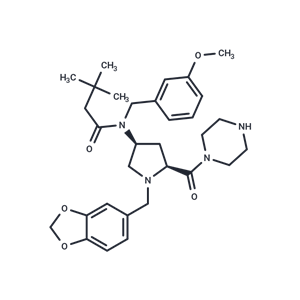产品属性:
产品名称 | 规格 | CAS号 | 型号 |
CUR 61414 | 5mg 10mg | 334998-36-6 | EY-Y0165428 |
Cas No.334998-36-6
别名 G-856
化学名 N-[(3S,5S)-1-(1,3-benzodioxol-5-ylmethyl)-5-(1-piperazinylcarbonyl)-3-pyrrolidinyl]-N-[(3-methoxyphenyl)methyl]-3,3-dimethyl-butanamide
分子式 C31H42N4O5

分子量 550.7
溶解度 ≤10mg/ml in ethanol;10mg/ml in DMSO;10mg/ml in dimethyl formamide
储存条件 Store at -20°C
General tips For obtaining a higher solubility , please warm the tube at 37 ℃ and shake it in the ultrasonic bath for a while.
Shipping Condition Evaluation sample solution : ship with blue ice
All other available size: ship with RT , or blue ice upon request
产品描述:
CUR 61414 is a potent inhibitor of hedgehog-induced cellular activity.
The link between basal cell carcinoma (BCC) and aberrant activation of the Hedgehog (Hh) signaling pathway has been well established in humans and in mouse models.
In vitro: Previous study found that CUR61414 was able to arrest proliferation of basal cells within the BCC-like lesions and induce cells to undergo apoptosis resulting in complete regression of the lesions, without affecting neighboring skin cells [1].
In vivo: The efficacy of CUR61414 against basaloid lesions induced when mice were exposed to UV light. These mice were UV irradiated for 6-9 months, producing many microscopic BCC-like basaloid lesions throughout their skin. Results showed that the treatment with CUR61414 could cause regression of these lesions, as demonstrated by both X-gal staining and histological analyses. Moreover, the regression in the CUR61414-treated mice seemed to be the result of massive cell death, becuase a significant increase in apoptotic nuclei was seen in basaloid nests after treatment. In addition, no overt toxicity was observed in the skin surrounding the lesions [1].
Clinical trial: So far, no clinical study has been conducted.
Reference:
[1] Williams, J. A.,Guicherit, O.M.,Zaharian, B.I., et al. Identification of a small molecule inhibitor of the hedgehog signaling pathway: Effects on basal cell carcinoma-like lesions. Proceedings of the National Academy of Sciences of the United States of America 100(8), 4616-4621 (2003).




